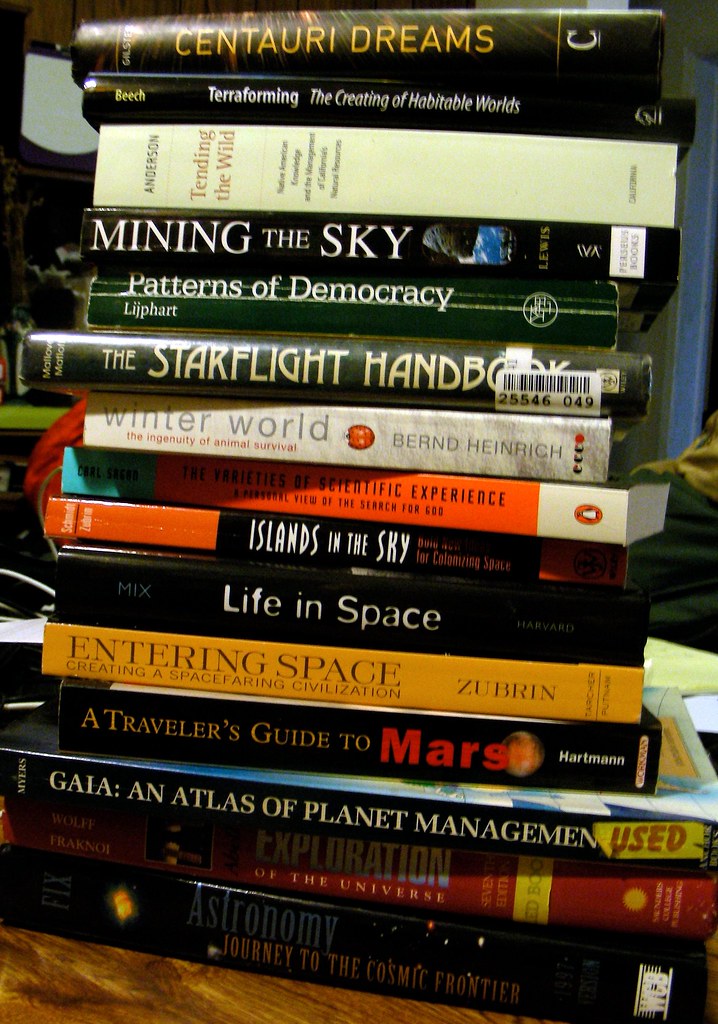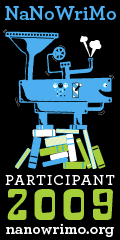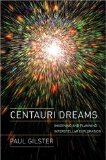This is my reading list for the rest of this month: front-end loading in preparation for NaNoWriMo 2009. [Note 1] Overly ambitious, I know: how can I possibly read that much in the time I’ve got left to me this month, on top of (1) working a fulltime job; (2) doing some major work on my website; (3) getting my apartment in comfortable shape for both winter & writing?
The answer, obviously, is: I can’t. But hey, I’ll give it a go with what I can go with.
Anyway, some of the books are more for backup reference than anything. I certainly don’t have time to read two complete astronomy textbooks, or some of those others bottommost on the pile. It helps that I have some slight background in astronomy — it was in fact my first major in college, true story, before I switched over first to studio art & finally religion. (Eclectic, much?)
Most of the books obviously are about space exploration — mainly the kind of stuff that’s actually in reach in the next century or so given the technology we have at hand now. And some of that stuff I’ve already read bits & pieces of, such that I already have some nicely hazy ideas about the progress that already counts as history to the characters of my projected NaNovel this year, Long Dark. [Note 2]
A couple of the books — Terraforming: The Creating of Habitable Worlds by Martin Beech and Winter World: The Ingenuity of Winter Survival by one of my favorite nature authors Bernd Heinrich (some of his other books are important background to another important project of mine, Mistress of Woodland) — are relevant more specifically to my 2007 NaNovel Cold, which is the NaNoWriMo project I definitely want to create as a full novel. Cold follows the lives of two young women, Boleyn Maheshwari & Bai Wang, on a planet in the late stages of terraformation. (Its first chapter is being published as the short story “Cold” that will appear in Crossed Genres Issue #12, scheduled for release on November 1.) It’s possible that some of my writing next month may take place on the planet itself, but at the moment those books are of a lower priority than some others.
So is Carl Sagan’s The Varieties of Scientific Experience: A Personal View of the Search for God which is placed in the pile mostly as a reflection of my sensibilities about the relationship between science & religion — which is to say, a very close one. And one which is reflected also in the sensibilities of many of my characters, whose approach to the universe they live in is, in fact, both scientific & religious, containing the appreciation & awe for the unending mysteries that are always before us. Because, as I’ve long thought, no matter how many questions are answered by science, there are always questions beyond them. That, in my view, is both the true attitude of science, & the true attitude of religion.
(You might surmise from this that I am no fundamentalist. You would be correct. My religious confession: God is the universe & everything in it. And also, except when it begins a sentence, god starts with a lower-case g. Because it’s not just floating around with a big white beard in the sky somewhere: it’s everywhere, both within you & outside you.)
Life in Space: Astrobiology for Everyone by Lucas John Mix and Tending the Wild: Native American Knowledge and the Management of California’s Natural Resources by M. Kat Anderson — interesting mix there, eh? Both are important to my interest in how life works on a planet but also to Jyoti’s lifework as a “farmer” in Long Dark. Or that’s how I see it. (And tip o’ the nib to Ptery, who suggested Tending the Wild‘s relevance to my story.) Here’s how I think it: I’ve read a lot about human nutrition, thanks to my efforts to avoid progressing from insulin resistance/prediabetes to full-fledged Type 2 diabetes; & one thing I’ve learned is that the human organism doesn’t function well on a completely industrialized diet of carbs in a box & other processed or industrially farmed foods. Even a great food source like salmon: wild salmon is much healthier, with a better omega-3 fatty acid profile, than farmed fish. (And wild salmon populations are under incredible stress right now: just check out what’s going on these days among the Alaska Native villages of Alaska’s Yukon-Kuskokwim Delta right now, where they can’t get enough food for winter because of low salmon runs.) — So how, then, does a human population that lives entirely in closed ecologies in outer space keep themselves nutritionally healthy? Jyoti’s insight: there needs to be some kind of wilding of their food sources, even in such completely artificial environments.
What about Patterns of Democracy: Government Forms and Performance in Thirty-Six Countries by Arend Lijphart? I bought a used copy of this book last year because it has a lot of info about consensus styles of government — in fact is, broadly, a comparison of consensus & majoritarian styles of democracy. Reviews of it at Amazon.com are mixed, but it’s one of the few sources I could find to help inform me & help me better develop the governmental form I chose for the space-based society my characters live in.
On the basis of governmental form alone, in fact, I could add a rereading of Kim Stanley Robinson’s Mars trilogy — Red Mars, Green Mars, & Blue Mars — & the related The Martians. In fact, those books would all be on the pile in my photo too, if I could’ve found ’em last night. These books were already important to my Cold & Long Dark projects as a marvelous depiction of the terraformation of Mars, which is why I first read them in early 2007. But what I didn’t expect when I first sat down to read them is that another theme which wound through them, of the political struggle between the corporation-dominated governments of Earth & the Mars colonists who wanted control of their own destiny, would prove so influential to my thinking about how the society in which Boleyn Maheshwari & Bai Wang live runs itself. By fortuitous circumstance, I spent a big chunk of my time in 2007 as an editor on Wikipedia articles, & thanks to some difficulties with a certain few problematic editors there, I had to go behind the scenes to learn how to navigate Wikipedia’s structure for batting doofuses into line & otherwise governing itself: a process of consensus that I found eerily similar to how Robinson’s Martians ultimately wrote their constitution. — And hence was the Consensus of Cold born. Fascinating, eh? I should dig up some of the backgroundy writing I did about that during NaNoWriMo 2007 when I was first formulating my ideas based on those to influences, & post it here.
Finally, at the top of the pile: the book I’m about a quarter of the way through now, Centauri Dreams: Imagining and Planning Interstellar Exploration by Paul Gilster. I think I first learned of this book through Gilster’s blog of the same name, which I found during preparatory research for my abortive NaNoWriMo attempt last year. My principal area of research then was the search for exoplanets — that is, planets in solar systems other than our own — & in particular the search for extrasolar terrestrial planets located in the the habitability zones where the temperature would be neither too hot nor too cold (amongst other things) to support Earth life. I was, of course, in a headlong hurry at the time — NaNoWriMo, & prep for it, tends to be like that — & my main interest at the time really was to develop a nomenclature for the planet my Cold characters were terraforming. (Can you believe it? — even now I don’t know the planet’s name: so far, I just call it XXXX. But that’s hard to pronounce.)
My reasoning was that in our own solar system, features on the Moon, Mars, etc. are frequently named after astronomers & other scientists involved with space exploration; thus, wouldn’t it be logical that at least some of the settlements or features on XXXX would be named after scientists who played important roles in the exploration of other solar systems? (Hence, the settlement where Bolyen & Bai live in Cold is named Turnbull, after Margaret Turnbull, one of the two astronomers who compiled the Catalog of Nearby Habitable Systems (HabCat) to narrow down the search for extraterrestrial intelligence (SETI), obviously useful in the search for systems with potentially habitable extrasolar planets like XXXX. The other of these astronomers is Jill Tarter, who was the inspiration for the main character Dr. Ellie Arroway in Carl Sagan’s novel Contact & portrayed in the movie “Contact” by Jodie Foster. Tarter is probably another name I’ll be using.)
But Centauri Dreams & my other space exploration reference books & blogs & websites are also, of course, important front-end-loading for other reasons. How else, besides reading stuff like this, am I going to have the faintest chance of giving some scientific believability to the story universe my characters inhabit?
By now you should see that I have a pretty complex lot of stuff I want to somehow blend into what I’m writing. It gets pretty overwhelming. Which is part of why Long Dark is shaping itself in my mind as a series of vignettes, short stories, & background writings: because I can’t sew it all into one now. In fact, it’s needed work to help me, I hope, sew Cold into one later.
How much later? Hard to say. Cold & Long Dark are October/November projects. (Pretty appropriate tittles, both of them, for going into the long cold Alaska winter, don’thca think?) In December, I’ll be picking up work on Mistress of Woodland again, which is just as complex in its own way.
Part of why it takes me so long to finish a damn thing.
Notes
- Translation of NaNoWriMo for those who haven’t read my previous posts on the topic: National Novel Writing Month, an annual event wherein scads & scads of people throughout the world — national in this case meaning the nation of truly crazy writers — who spend the month of November churning out 50,000-word “novels” which may or may not be remotely publishable by the stroke of midnight that turns November 30 into December 1. Please join us!
- I use even the term NaNovel very loosely: Long Dark, which takes place in the same story universe as my 2007 NaNovel Cold, will most likely be a series of vignettes, roughly written short stories, background pieces, etc. over the timeline of the story universe. I imagine any “final” projects coming out of it as being short stories & appendices to my biggest project in this universe, the novel-in-progress Cold.



